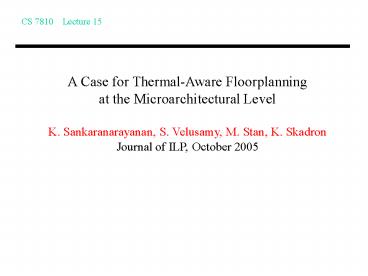CS 7810 Lecture 15 PowerPoint PPT Presentation
Title: CS 7810 Lecture 15
1
CS 7810 Lecture 15
A Case for Thermal-Aware Floorplanning at the
Microarchitectural Level K. Sankaranarayanan, S.
Velusamy, M. Stan, K. Skadron Journal of ILP,
October 2005
2
Importance of Temperature
- High power density ? cooling tech must improve
- Every additional watt increases chips
cooling/packaging cost by 4 - Higher temperature ? exponentially higher
leakage - Temperature variations cause wear and tear
3
General Approaches
- Reduce overall power consumption
- Wait for some unit to reach temperature limit
and - then throttle back (dynamic thermal management)
- Better floorplans so that heat is evenly
distributed - and likelihood of local hotspot is reduced
- Better floorplanning does not eliminate
the need for DTM
4
Thermal Modeling
- Thermal resistance models the rate at which
heat passes through - Thermal capacity models the temperature rise
because of heat absorption
Resistance a thickness / area
Capacitance a thickness x area
5
Models for Alpha-like Processor
6
Effect of Lateral Spreading
Thermal resistance 0
Thermal resistance infinity
7
Simulation Setup
- Ambient temperature of 40o C
- Trigger threshold (when DTM is invoked) 111.8o C
- Emergency threshold is 115o C
- Alpha core is 6.2mm x 6.2mm cross-core latency
- is 4.21 and 7.16 cyc (on different metal
layers) - L2 cache is wrapped around the core to form a
- square
8
Simulated Annealing
- In each iteration, perturb the solution with a
- probability that equals the difference between
- the quality of current and optimal solution
- What is the metric for quality?
- ( A lW ) T
- W S cij dij
A is area some layouts increase the
amount of white space W is the performance
penalty becoz of wire delays T is peak
temperature for the layout d is the distance
between units in cyc c reflects the performance
impact of that distance
9
Inputs to Algorithm
- Profile a subset of benchmarks to estimate power
- density of each block
- Profile the performance impact of each set of
wire - delays to determine weights
10
Wire Delay Penalties
11
Optimal Floorplans
Flp-basic each wire delay gets an equal weight
Dead space 1.14 5.24
Total wire length is longer here
Flp-advanced wire delays are weighted
12
Impact on Peak Temperature
Additional temp. reduction becoz of poorer IPC
and lower leakage
13
Comparison with DTM (DVS)
DVS Assumes 10ms overhead for a change DVS-i
Assumes no overhead for a change
Emergency threshold
14
Title
- Bullet

